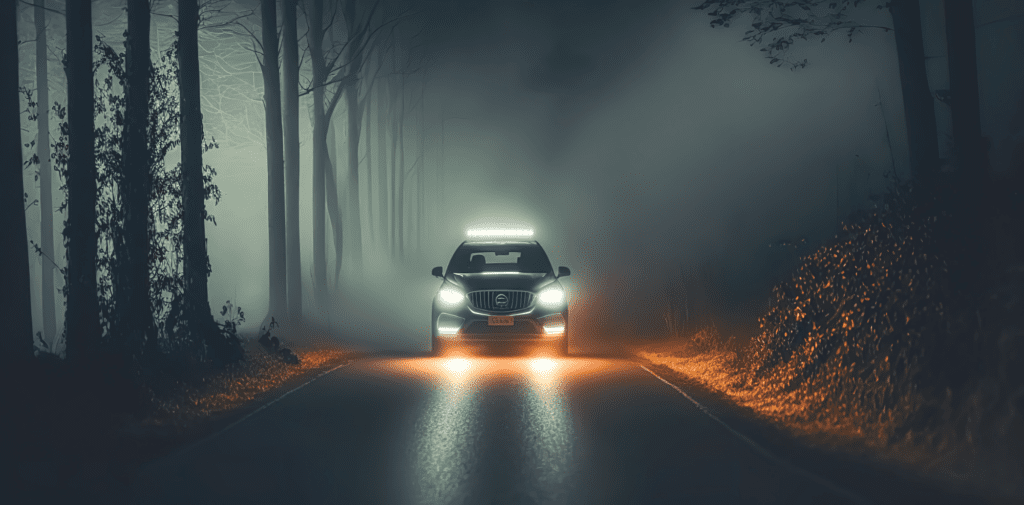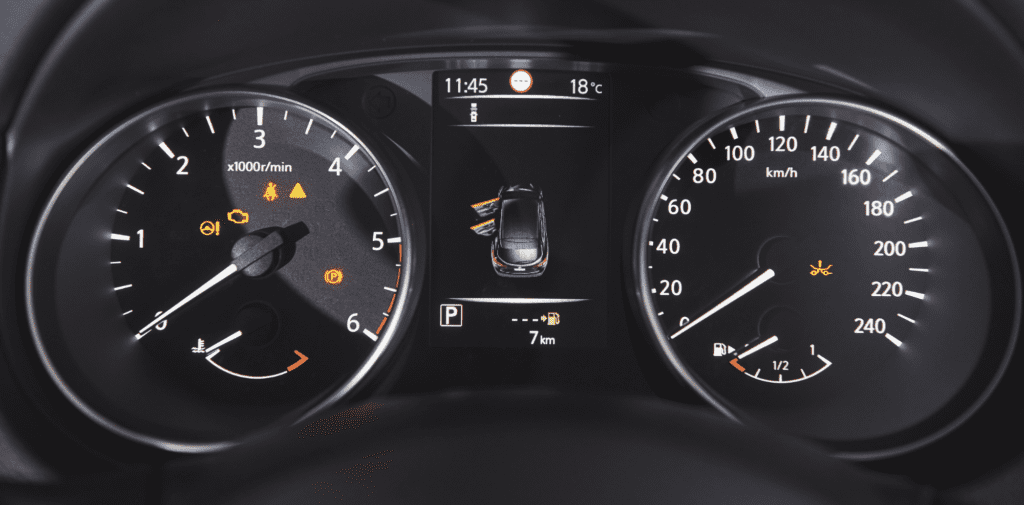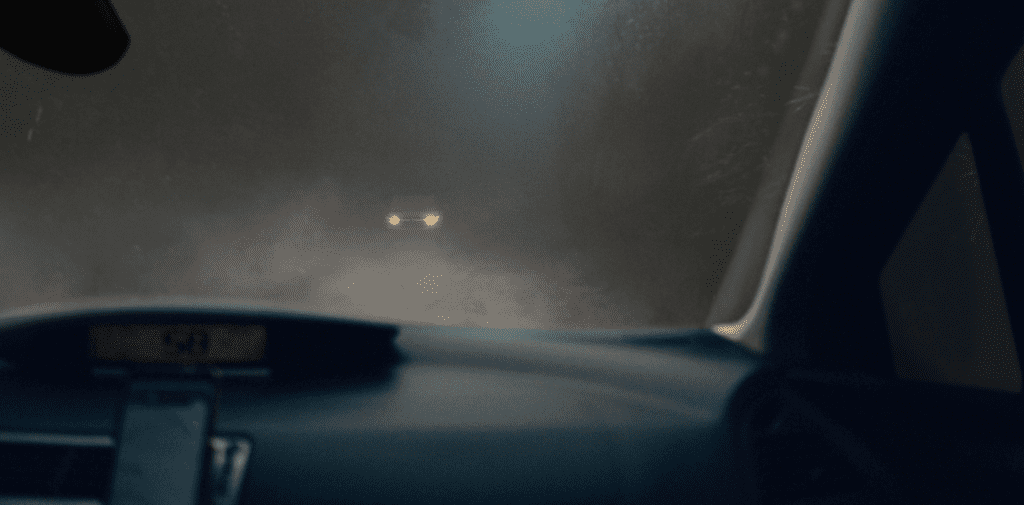
Driving in fog presents unique challenges and requires your full attention and adherence to safety measures. Fog significantly reduces visibility, making it crucial to understand and follow guidelines to ensure your safety and the safety of others on the road.
Understand the Basics
Fog is a weather condition that can make driving difficult and hazardous. It’s important to be familiar with the rules and recommendations for driving in such conditions to maintain safety.
Follow the Highway Code
The Highway Code provides specific instructions for driving in fog. One key rule is to always use your dipped headlights when visibility is poor. This helps other drivers see you, even in thick fog.
Using Fog Lights Appropriately
Fog lights are designed to improve visibility during foggy conditions. However, it’s crucial to use them correctly to avoid causing problems for other road users. Understanding when to use your fog lights, and when not to, can help prevent accidents and ensure compliance with the law.
Fog Lights
Understanding the correct use of fog lights is essential for safe driving in poor visibility conditions. These lights are designed to improve your visibility on the road during foggy conditions without causing glare that can affect other drivers.
Legal Requirements for Fog Lights
In the UK, the law mandates that all vehicles must be equipped with rear fog lights. These are typically red and located below the brake lights, helping other drivers to see your vehicle in reduced visibility.
Additionally, many vehicles come with front fog lights. Their low position and specific angle are intended to enhance your visibility ahead by cutting through the fog, without the light reflecting back at you, which can happen with full-beam headlights.
Guidelines for Using Fog Lights
According to The Road Vehicles Lighting Regulations 1989, there are clear guidelines for the use of fog lights to ensure safety and avoid causing discomfort to other road users:
- Fog lights should only be used when they do not cause undue dazzle or discomfort to others.
- They should be activated only in conditions of seriously reduced visibility, which the Highway Code (Rule 226) defines as being unable to see more than 100 metres (328 feet) ahead. This distance is roughly the length of a football pitch, offering a practical reference point for drivers.
- Fog lights should be used while driving and must not remain on when the vehicle is parked, unless in an emergency situation.
Following these guidelines helps maintain safety on the road for you and other drivers, especially under challenging weather conditions like fog.
When Should You Turn Your Fog Lights On?
Determining the right moment to activate your fog lights is crucial for ensuring safety and compliance with road regulations during foggy conditions.
Assessing Visibility
To gauge when to use your fog lights, understanding the concept of visibility distance is key. 100 metres is a significant measure since it is the minimum visibility distance at which fog lights should be considered. This distance can be hard to estimate, especially under challenging weather conditions.

Practical Test for Visibility
When driving at 30mph, 100 metres is roughly equivalent to a duration of less than eight seconds. You can practically test this by focusing on a stationary object in the distance, such as a road sign, building, or streetlight.
As soon as the object becomes barely visible, start counting the seconds it takes until you pass it. If it takes more than eight seconds, this indicates that the object is more than 100 metres away, and the visibility is relatively better than the threshold for using fog lights.
However, if you find yourself counting less than eight seconds, it’s advisable to turn your fog lights on to enhance your view and ensure your visibility to other drivers is maintained.
What Happens If You Use Fog Lights Inappropriately?
Using fog lights when not warranted can have legal consequences and pose safety risks to yourself and other road users. Understanding the appropriate conditions for fog light use is essential to avoid penalties and ensure road safety.
Potential Penalties
Misuse of fog lights can result in receiving a Fixed Penalty Notice or a fine. Specific instances that can lead to this include using fog lights:
- As a substitute for another broken light, which is not their intended purpose.
- On clear nights merely to enhance vision, which is unnecessary and can be hazardous.
- When visibility is not significantly reduced to justify their use, leading to potential safety hazards for other drivers.
Safety Implications
Inappropriately using fog lights, especially rear fog lights, can dazzle other drivers and make it difficult for them to see, increasing the risk of accidents.
Moreover, rear fog lights can obscure your brake lights, making it challenging for drivers behind you to realise when you are slowing down, as highlighted in Rule 236 of the Highway Code.

Best Practices
It’s crucial to remember to turn off your fog lights as soon as visibility improves. This not only complies with regulations but also promotes safer driving conditions for everyone on the road.
How to Turn On Your Fog Lights
Activating your fog lights is an important safety measure in poor visibility conditions. However, the method to turn them on can vary significantly between vehicles.
Identifying Fog Light Controls
Every car has a unique set of controls for operating its lights, including fog lights. These controls could be in the form of a knob, stalk, or button that you might need to turn, twist, pull, or push. To distinguish between the two types:
- The rear fog light symbol typically represents this function for the lights at the back of your car.
![]()
- The front fog light symbol indicates the control for the lights at the front.
![]()
Finding Your Fog Light Controls
If you’re unsure where these controls are in your vehicle or how to operate them, the first step should be to consult your vehicle handbook.
This manual will provide detailed instructions specific to your car model, ensuring you can safely and effectively use your fog lights when necessary.
What Else Should You Do to Drive Safely in Foggy Weather?
Driving in foggy conditions demands extra precautions beyond just making yourself visible. The Highway Code offers several valuable guidelines to enhance safety during such weather.
Ensure Clear Visibility
Before setting off, it’s essential to have clear windows. Utilise your demisters and windscreen wipers effectively, directing the heat towards the windscreen to prevent it from misting up again. These may need to remain active throughout your journey to maintain clear visibility.
Adjust Your Speed
Research from the Met Office highlights a common issue where drivers might speed up in fog due to altered perception caused by reduced visibility. Objects like trees and buildings become blurred, affecting our speed judgement. To counteract this:
- Regularly monitor your speedometer to keep track of your actual speed.
- Gradually reduce your speed before entering foggy areas.
- Use your brakes rather than merely decelerating to signal to following drivers that you are slowing down.
- Increase the distance between you and the car in front to ensure you can stop safely within the distance you can see clearly.
- Maintain a safe speed, even if pressured by tailgaters.

Be Vigilant of Other Drivers
Not all drivers may remember to use their fog lights or even their headlights. Drive with caution and stay attentive to any signs of movement from other vehicles.
Maintain Proper Road Positioning
Adverse weather conditions underline the importance of adhering to sound driving principles. Stay within your lane and ensure you are correctly positioned at junctions to avoid confusion and potential accidents.
Use All Your Senses
In instances where visibility is severely compromised, your hearing can provide additional information about your surroundings. At junctions, consider winding down your windows to listen for oncoming traffic.
Be Cautious Yet Decisive
When it comes to making movements, ensure your actions are safe and well-considered. However, once you decide to move, do so without unnecessary delay. Hesitation can increase the risk of accidents, particularly in foggy conditions where visibility is limited.
Checklist Before Driving in the Fog
Preparing to drive in foggy conditions requires careful consideration and specific checks to ensure your journey is safe and compliant with safety regulations.

Familiarise Yourself with Your Fog Lights
The first step is to ensure you are fully acquainted with how to activate both your front and rear fog lights. Knowing how to turn these on quickly and efficiently is crucial for safe driving in fog.
Check Your Fog Lights Are Operational
Before setting off, it’s important to verify that all your fog lights are functioning correctly. You can do this by switching them on and then walking around your vehicle to visually confirm they are illuminated. Alternatively, use a reflective surface, such as a window, to check that the lights are indeed lit.
Assess the Necessity of Your Journey
Finally, consider the severity of the fog and ask yourself if the journey is essential. Given the increased risks associated with driving in such conditions, it might be prudent to delay or cancel your trip if possible. Prioritising safety is key in ensuring not only your well-being but also that of other road users.
Frequently asked questions
Full-beam headlights are designed to illuminate the road over long distances. While this feature is beneficial under clear conditions, it is not advisable to use them in fog.
The reason behind this is that fog causes the light to be reflected back towards the driver, which can impair visibility even further.
In foggy conditions, it is recommended to use dipped headlights and fog lights, particularly when visibility is reduced to less than 100 metres.
This approach helps to ensure a safer driving experience by improving visibility without the risk of glare from the fog.
If there is heavy fog, your practical driving test might be cancelled due to safety concerns. Should you be anxious about the weather affecting your test, it is advisable to monitor your emails closely and contact the test centre for updates. The contact details for the test centre can be found in your booking confirmation.
It is important not to assume that your test is automatically cancelled because of foggy conditions in your area, as fog can be very localised. This means that while it might be foggy where you are, the conditions on the test route might not be impacted.
In the event that your test is cancelled, you will be automatically allocated a new test date.
Freezing fog occurs when droplets of water, which are below 0ºC, form in the air and then freeze upon contact with surfaces, like your car’s windscreen.
Although this phenomenon is not very common at ground level, it does occur from time to time. It’s important to be prepared for such conditions by knowing how to clear your windscreen efficiently.
This involves the use of demisters and adjusting the heat settings in your vehicle. To prevent the build-up of ice on your windscreen overnight, you might consider using a windscreen cover as a protective measure.


